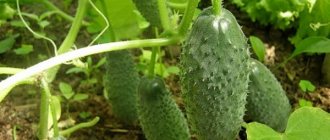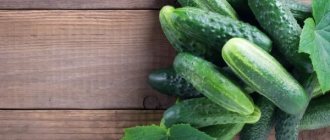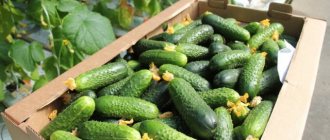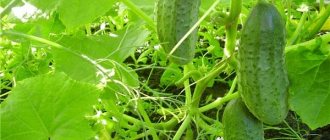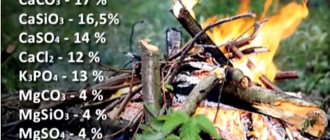Emelya F1 cucumber is one of the hybrids that are increasingly replacing conventional cultivars every year. Like many hybrid varieties, it has increased yield, excellent immunity, taste without bitterness and the ability to withstand adverse conditions.
| Landing location | Ripening time | Mode of application | Fruit length | Group | Fruit smoothness | Pollination method |
| Universal | Early ripening (35-45 days) | Universal | Medium - from 10 to 15 cm | Hybrid | Highly lumpy | Parthenocarpic |
Description and characteristics of the variety
The hybrid was created by breeders. Since 2002, it has been included in the State Register of the Russian Federation. It can be grown anywhere: in open ground, greenhouses, temporary film shelters and on balconies. The bush has medium branches, it has short internodes, which is why the bunches with ovaries are located more often. The leaves are smooth, with slightly wavy edges. Flowers do not need pollination. Up to 7-10 fruits can develop in one bunch. They ripen 40-45 days after the sprouts appear. The length of the fruit reaches 13-15 cm, weight - 120-150 g. The skin is thin, dark green, with a small number of large tubercles. The spines are white and have light fluff. The pulp is without bitterness, very tasty and juicy. The fruits are used for harvesting and fresh consumption.
What varieties of cucumbers should I choose for growing in greenhouses?
Cucumber is an annual plant of the Cucurbitaceae family that can grow upward, wrapping its tendrils around supports. Thanks to this feature, it is grown in a greenhouse on a trellis, saving space. It has a root system that is poorly restored after damage, so experienced gardeners recommend: using large-volume pots when using the seedling method of cultivation; when sowing seeds in the ground, thin out, not tearing out excess plants from the ground, but cutting off their above-ground part; When weeding and loosening, be very careful not to touch the roots. The appearance and size of the greens depends on what varieties of cucumbers are planted for greenhouses.
Each variety of cucumbers has different ripening times, different methods of care and the amount of harvest they produce.
General characteristics of greenhouse varieties
The best results in greenhouse cultivation are obtained by early self-pollinating and parthenocarpic hybrids, bred specifically for use in greenhouses. The difference between parthenocarpic and self-pollinating varieties is that the former produce greens without pollination and have no seeds, while the latter have a pistil and stamen in one flower and pollinate themselves, so their fruits have seeds. Both hybrids can be grown in an apartment on a windowsill. Emelya F 1, Dynamite F 1, Claudia F 1, Crispina F 1, Amur F 1, Zozulya F 1, Mother-in-law F 1, Zyatek F 1 - the best greenhouse hybrids.
Scheme of cucumber varieties.
If greenhouse hybrids are pollinated by bees, the greenery will turn out to be a curved, ugly shape. Bee-pollinated varieties are best planted in open ground
The growing method differs only in that self-pollinating hybrids must sometimes be gently shaken. If you have chosen parthenocarpic hybrids, it is good to plant a pollinating variety of cucumbers nearby; otherwise, with multiple flowers, there will be few fruits
Universal varieties are distinguished by brownish or black thorns; they are suitable for salting and pickling, as well as for fresh consumption. Fruits with white spikes are best used as salad fruits.
Popular varieties for greenhouses
As a rule, I plant parthenocarpic hybrids, but every year it becomes more and more difficult to choose which variety is best to plant, since breeders are developing new hybrids that can be planted in greenhouses and hotbeds, let’s look at the best of them:
Emelya F 1 is an early-ripening (39-43 days), high-yielding, parthenocarpic variety of cucumbers for pickling, which was originally bred as a salad variety. Flowering type: bouquet. Greens are spindle-shaped from 13 to 15 cm, with white pubescence and thin skin. The variety is resistant to major diseases affecting cucumbers.
Hercules F 1 is a universal, long-climbing, high-yielding (from 15 to 18 kg) parthenocarpic variety of cucumbers with a bouquet type of flowering. The fruits are cylindrical, small (from 12 to 14 cm), with brownish pubescence. More suitable for growing under film cover, rather than for winter greenhouses, where yields may be reduced due to lack of space.
Crispina F 1 is a high-yielding, parthenocarpic hybrid with a powerful root system. It produces a large harvest when grown by seedlings; three-week-old seedlings are planted in greenhouses. Zelentsy are elongated, with large tubercles and white spines.
Mother-in-law F 1 is an early, cold-resistant, disease-resistant parthenocarpic hybrid, grown both in open ground and in a film greenhouse. Fruits from 11 to 13 cm, with large tubercles and brownish spines, are good for canning.
Stages of growing cucumbers.
Zyatek F 1 is an early-ripening, disease-resistant, medium-yielding (from 5 to 7 kg) parthenocarpic hybrid. Cucumbers are oval-shaped, from 9 to 11 cm long, with frequent tubercles and white spines with excellent taste. The variety is well suited for making pickles and gherkins.
Matrix F 1 is a cold-resistant hybrid of the female flowering type, resistant to all types of diseases, grows well both in greenhouses and in open ground. It is distinguished by friendly harvest yield.
Orpheus F 1 - Early ripening, high-yielding, self-pollinating hybrid. Zelentsy are cylindrical, with small tubercles and light stripes, with a complete absence of bitterness.
Zozulya F 1 is an early, cold-resistant, long-bearing, productive, partially self-pollinating hybrid. The fruits are long, cylindrical, with faint tubercles and white spines.
Amur F 1 is a mid-early, self-pollinating, high-yielding variety suitable for cultivation in protected and open ground, bred in Holland. Gherkin-type greens, with good taste, suitable for canning.
Which varieties to choose is up to you; with proper care, all of them will delight you with a good harvest.
ParnikiTeplicy.ru
Landing
The hybrid is grown by seedlings or planted directly into the ground. The second method is suitable for gardeners from the southern regions, and the first - for those who live in a cool climate or want to get a harvest faster.
Hybrid seeds are treated with fungicides before packaging. But if there are concerns about the health of the bushes, the seed can be soaked in a one percent solution of potassium permanganate for several hours.
For seedlings, prepare nutritious soil containing peat. Peat pots are suitable as containers. One seed is placed to a depth of 2 cm in each pot, moistened and covered with film. Germinate in warmth, then lower the temperature and move the seedlings to a sunny place.
If necessary, feed once. After 20-30 days, you can transplant the bushes into the garden bed.
Sow directly into the soil when it warms up to +14-15 degrees. The soil is prepared in the fall: they dig deep and add manure. In the spring, they dig up the area again, add some mineral fertilizers and place 3-5 holes per 1 square meter. m.
It is necessary to choose sunny, wind-protected areas where tomatoes, peppers, potatoes, cabbage, dill or mustard grew in previous years.
Growing and care
Cucumbers are watered regularly as needed. Usually this is once every 3-4 days, but in hot weather it can be done daily or every other day. Warm water is used, watering is carried out in the morning or evening, so that the plants do not receive direct sunlight at this time.
Regularly pull out weeds and carefully loosen the soil at least once a week. To allow oxygen to reach the roots, it is enough to periodically pierce the crust on the soil surface with a pitchfork.
Bushes, especially in a greenhouse, should be tied up. In a greenhouse, it is recommended to attach it to a vertical trellis. This will allow the plant to receive more air and light. In protected ground, the bush requires moderate pinching.
Fertilizing is applied 4-5 times per season. At the beginning of development, cucumbers need nitrogen, which is contained in manure, bird droppings and nitrate fertilizers. When the bushes bloom, preparations with a predominance of phosphorus are applied, and when they begin to bear fruit, potassium and nitrogen are applied.
The best varieties for growing in a greenhouse
The unpredictability of the climate in central Russia forces summer residents to consider the option of growing cucumbers in a greenhouse, which makes it possible to create optimal microclimate conditions for obtaining a good and stable harvest. Among the large number of varieties offered by seed stores, you should choose a variety in accordance with your own preferences and purpose of cultivation. What greenhouse varieties of cucumbers have in common is their resistance to disease, namely the “scourge” of all cucumber crops - powdery mildew.
Among the greenhouse hybrids there are representatives of self-pollinating types and those requiring the participation of insects, there are early and late ripening, large and small. Among those that have gained the greatest popularity are:
Suomi (F1 hybrid)
A hybrid that resists disease and unstable weather very well. It was created specifically for growing in cool climates. The duration of fruit ripening does not exceed 38 days, which classifies it as a super fast variety. Another feature is the inability of a ripe cucumber to outgrow, which will make it possible to obtain an ideal harvest in any conditions. The hybrid is well suited for pickling and fresh consumption in salads.
Valaam hybrid
A cold-resistant variety, as can be understood from the name, which also differs in the speed of fruit ripening. Cylindrical cucumbers are very short in length, no more than 6 centimeters, but have an increased diameter. A feature of the variety is the absence of bitterness and limited fruit growth. The plant can bear fruit almost until frost.
Sarovsky (hybrid form F1)
A distinctive feature of this hybrid, which can resist powdery mildew, is the bouquet nature of fruiting. This means that several cucumbers can start from one leaf axil at once. The plant has no side shoots. This hybrid is of interest to residents of northern regions, since it can grow even in conditions of lack of lighting and decreased air temperature.
Orpheus (F1 hybrid)
Self-pollinating cucumber hybrid, characterized by a high level of fruiting. The small fruits, which, unlike most cucumbers, do not have a persistent green color, but are slightly striped, are devoid of bitterness and can be used for salads and fresh food.
Glafira (F1)
Another hybrid form that has a female flowering type. This variety belongs to the salad variety, since the length of the fruit reaches 20 centimeters, and the weight of each cucumber can exceed 160 grams. The plant can successfully bear fruit in low light conditions, producing fruit even in cloudy weather outside
Another important feature is resistance to powdery mildew and other “cucumber” diseases.
The cucumber is classified as a pickling cucumber due to the balanced size of the fruit, which does not exceed 10-12 centimeters. Each cucumber has a rich dark green color and an almost complete absence of tubercles. The duration of the vegetative period from the ovary to the finished fruit is from 50 to 60 days.
In addition to the usual varieties, a type called “gherkin” has recently gained popularity. This is a type of cucumber, characterized by its small size, used mainly for pickling or pickling. Growing cucumbers is a simple and interesting process. If you follow all the points when choosing seeds, you will be able to get a good and, most importantly, tasty harvest, which will delight you not only fresh, but also as winter preparations.
